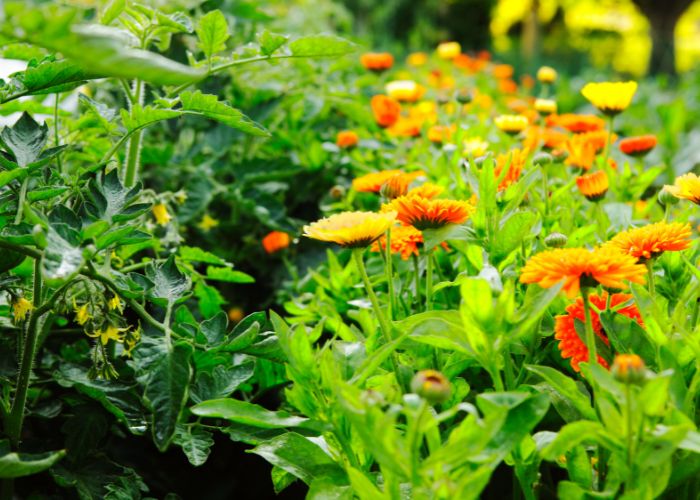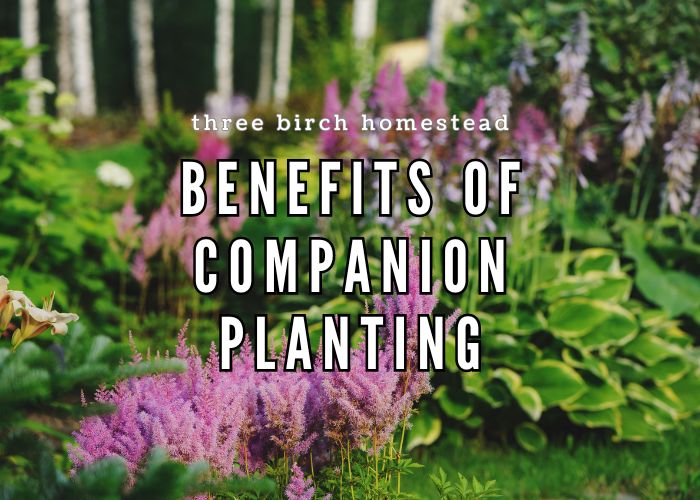Nature knows best, and you can borrow from nature to boost your garden’s productivity. Utilizing the benefits of companion planting is one way to do that. In this article, you will find out why companion planting could be the game-changer your garden needs. From strengthening plant growth to getting a bumper crop yield, the benefits are as diverse as they are significant.
What are the Benefits of Companion Planting?
Companion planting is a gardening technique where different plants are grown together to help them thrive. Benefits include improving soil quality, deterring pests, and increasing crop yield. It is a natural and effective way to improve the health and productivity of your garden.
Table of Contents
- What are the Benefits of Companion Planting?
- What is Companion Planting?
- The Benefits of Companion Planting
- How to Start Companion Planting
- My Personal Experiences with Companion Planting
- Conclusion
- What do you Think?
What is Companion Planting?

I’m going to introduce you to an intelligent and functional gardening practice that has been used for centuries: companion planting. Gardening isn’t just about making things beautiful; it’s also about harnessing the power of plant relationships to support a thriving ecosystem right in your backyard.
What is companion planting? Companion planting is the strategic placement of different crops in close proximity for pest control, pollination, providing habitat for beneficial creatures, maximizing use of space, and to otherwise increase crop productivity. This technique taps into the natural advantages that plants can offer each other.
The Benefits of Companion Planting
Enhanced Plant Growth and Yield
When you introduce the right companion plants into your garden, they can support each other in various ways, contributing to overall plant growth and yield. Let’s jump straight into the heart of companion planting dynamics.
Consider classic pairings like tomatoes and basil or corn and beans. Not only do these combinations exemplify mutual benefits – such as tomatoes deterring pests from basil and beans fixing nitrogen in the soil for corn – but they also showcase how plants can bolster each other’s growth.
Basil is believed to bolster tomato growth through a variety of mechanisms. One of the main ways that basil can benefit tomatoes is by repelling certain pests that can harm tomato plants. Basil contains natural compounds that are toxic to insects like whiteflies and spider mites, which are common pests that attack tomato plants. By planting basil alongside tomatoes, gardeners can help protect their tomato plants from these pests without the use of harmful pesticides. Additionally, basil and tomatoes have similar nutrient requirements, so planting them together allows them to share nutrients and maximize their growth potential. Finally, some studies have suggested that basil may produce compounds that stimulate tomato growth and improve fruit quality.
Beans can bolster corn growth through a process called nitrogen fixation. Beans are able to convert atmospheric nitrogen gas into a form of nitrogen that plants can use. When beans are planted alongside corn, they can help to increase the amount of nitrogen available to the corn plants, which is an essential nutrient for growth. Additionally, beans have a fibrous root system that can help prevent soil erosion and improve soil structure, which can benefit the corn plants as well. Finally, planting beans and corn together can also help to deter certain pests that are attracted to corn, such as corn borers, by masking the scent of the corn plants.
These are just a couple of examples of companion planting and how it can enhance plant growth and yield.
Natural Pest Management Solutions
Companion planting doesn’t just support plant growth; it’s also a remarkable strategy for managing pests naturally. Have you ever wondered if a simple plant could save your garden from an infestation? Guess what? They can.
Certain plants have built-in defense mechanisms that repel specific insects. For example, marigolds are known to deter nematodes and other pests with their pungent odor, making them a fantastic companion for a variety of vegetables. Nasturtiums can be planted near cucumbers, squash, and melons to repel aphids and squash bugs. Chives, onions, or garlic can be planted near carrots to help repel carrot flies.
By strategically placing companions, gardeners can often sidestep the need for harmful chemicals. But this isn’t just about avoiding toxins; it’s also about fostering a more natural garden environment.
Improvement of Soil Health and Structure
As you probably know, the health of your garden starts from the ground up. Soil is the foundation of a thriving garden, and companion planting can significantly enhance its quality. Let’s look at how this works.
Some plants play a key role in nourishing the soil. You might have heard about nitrogen-fixing plants, such as legumes, which have a unique ability to convert atmospheric nitrogen into a form that plants can use. When you plant these alongside other crops, your soil gets a natural nutrient boost.
It’s not just about adding nutrients, though. The architecture of a plant’s roots can also improve soil structure. Deep-rooting companions help to break up compact earth, allowing air and water to penetrate more effectively and roots to grow more freely. Plants such as alfalfa, clover, radish, buckwheat, and mustard have root systems that can break up compact soil. By planting these companion plants in your garden, you can improve the health and growth of your plants.
But the benefits continue beyond there. The decomposition of plant material returns organic matter to the soil, providing food for microorganisms. This, in turn, keeps the soil healthy and alive. With better soil structure and fertility, plants can withstand adverse conditions better, require less water, and provide healthier, more bountiful harvests.
Isn’t it fascinating to see how nature’s life cycle supports a thriving garden?
How to Start Companion Planting
Starting companion planting is relatively easy, and it begins with selecting the plants you want to grow. Research which plants grow well together and which ones don’t. Some plants are incompatible; planting them together can hurt their growth or attract pests. For example, fennel does not make good companions with most plants because it produces chemicals that can inhibit the growth of other plants around it.
Once you have decided on your plants, you can start planting them in your garden. Group the companion plants together so they have the greatest impact on each other.
Some of the best companion plants for beginners are marigolds, basil, and chives. Marigolds help repel pests, while basil and chives attract beneficial insects like bees and ladybugs to your garden. Another great option is to plant tomatoes with lettuce or spinach, which can help shade the soil and keep it cool. This can be especially beneficial during the hot summer months. Additionally, planting beans with corn and squash can create a natural support system that benefits all three plants. These are just a few examples, but there are many other great companion plants to explore as well.
My Personal Experiences with Companion Planting
When I plan my garden, I usually refer to the book, “Carrots Love Tomatoes,” to get an idea of what plants do well together, and I plan accordingly. I have yet to do intensive companion planting, but I always make sure I don’t put things that are bad for each other next to each other.
This coming gardening year, I want to do more companion planting and experiment with plant pairings that help each other grow stronger. I will let you know how it goes!
Conclusion
Companion planting is a technique that utilizes different aspects of plants to benefit and complement other plants. It is a well-thought-out system that increases crop yields, reduces pests and the need for chemical pesticides, and enhances soil fertility. Try it in your garden today and see how beneficial it is!
What do you Think?
What do you think of companion planting? Do you utilize companion planting in your garden? What plant pairings are you excited to try out? Let me know in the comments section below! I love to hear from you, and I always respond. Together, let’s cultivate bountiful gardens!
